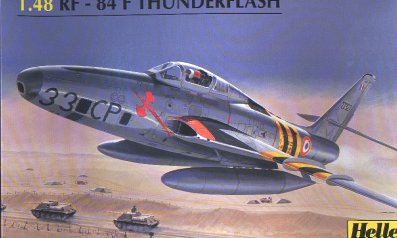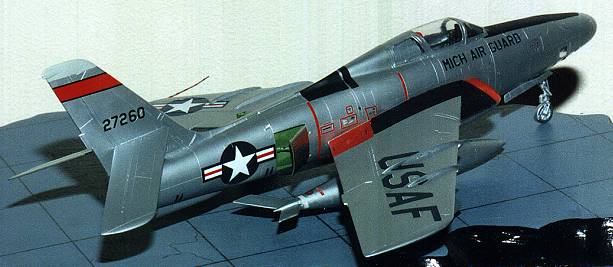
Heller 1/48 RF-84K Thunderflash
Kit Number: 417
Price: $19.95
Decals: Two versions: a Suez Crisis French aircraft from ER33 in bare metal and a camouflaged version from AKG 51 with the Luftwaffe.
Date of Review: 20 November 1997
Reviewer: Scott Van Aken

Suffice it to say that the RF-84F was the most widely used US recce aircraft of the early cold war and was used by friendly nations as well as the USAF and ANG until replaced by the equally widely used RF-4 Phantom. The last operational RF-84F was finally retired from service with the Greek Air Force in 1991; not bad for an aircraft that first entered service with the USAF in the early '50s.
The version I modeled is the rather rare RF-84K. Initially built for the FICON (Fighter Conveyer) program where a B-36 kept an RF-84K in its bomb bay and released it for later recovery via a rather interesting hook/trapeze device, the K version was basically the same as the F in service at the time. A total of 25 were built and entered squadron service with the 71st SRWs 25th and 82nd SRS. After only a little over a year, the program was quietly dropped and the aircraft sent to other units, including the 45th TRS at Misawa, Japan as well as various test and research units. At least seven were assigned to the Michigan ANGs 107th and 171st TRS. Several still exist in museums. The main distinguishing feature of the RF-84K was the 23 degrees of anheadral added to the tailplanes so they would clear the bay of the RB-36. There is also a small door forward of the windscreen that contains the retractable hook. No other modifications were made as the RF-84F is a very strong aircraft.
On to the kit. This kit has been around for over 15 years, but has very good raised detailing and a rather well detailed cockpit for the time. The instrument panel is well detailed, but is for an F-84F. There is a decal depicting the correct RF-84 instrument panel that should be used. The rest of the construction is very standard and I had only one area of fit problems and that was caused by the nose section of one of the fuselage halves becoming damaged during the kits long trip from France. This half had been torn at a nose camera window location. I thought I could properly repair it with no difficulty, but my repairs were not successful and so I had to do a lot of putty and file work to get it to look right. I had no problems attaching the many camera windows and would recommend white glue (such as Elmer's) to do this job.
Modifying the tailplanes was a straightforward job of beveling the mounting point and enlarging the attachment holes to take the mounting tabs at an angle. A touch of putty was all that was required to fix the area after modification. Other than the aforementioned problem area, there are only two areas that I would have liked to have seen done better. One was to have a canopy that could be displayed open. There is more to it than just cutting the canopy as the mechanism is rather unique and would have resulted in carving a panel out of the clear plastic as well as the hinge mechanism. Another is the nose wheel. It is part of the strut assembly and not separate. I guess this was done for strength as the F-84 nose gear looks rather fragile and a separate nose wheel would have made this area weaker. As it was, I added considerable weight to the nose to prevent tail sitting.
The markings came from an old Bare Metal Foil sheet that includes
 markings
for four Michigan ANG aircraft including an RF-84K. The wing markings are
indeed quite large and I would have thought them to be smaller, but they
do fit. A word of warning with the RF. There are wing fences
on this plane and they should be added AFTER the decals have been put on.
Otherwise you will have to do quite a bit of cutting. The same
holds true for the underwing USAF marking. This also covers a part
of the landing gear door. While it can be cut after installation, it
is easier to apply over the closed door and then cut. The aircraft
is in bare metal with red intake warning areas and black wing walk and dielectric
panels. These areas need to be painted on as they are quite large and
would not look good with just a decal (none provided, anyway). Other than
that, the only color is provided by a red tail band. I found a photo
of this plane in 'Aircraft of the ANG', by Rene Francillion.
markings
for four Michigan ANG aircraft including an RF-84K. The wing markings are
indeed quite large and I would have thought them to be smaller, but they
do fit. A word of warning with the RF. There are wing fences
on this plane and they should be added AFTER the decals have been put on.
Otherwise you will have to do quite a bit of cutting. The same
holds true for the underwing USAF marking. This also covers a part
of the landing gear door. While it can be cut after installation, it
is easier to apply over the closed door and then cut. The aircraft
is in bare metal with red intake warning areas and black wing walk and dielectric
panels. These areas need to be painted on as they are quite large and
would not look good with just a decal (none provided, anyway). Other than
that, the only color is provided by a red tail band. I found a photo
of this plane in 'Aircraft of the ANG', by Rene Francillion.
Overall the aircraft looks quite good and is larger than I would have thought in this scale. There are a number of aftermarket schemes for this aircraft, although the resin and photoetch crowd seem to have missed this one. The Heller kit is still readily available from a number of sources so if you like the Thunderflash, I can recommend this one.
Copyright ModelingMadness.com. All rights reserved. No reproduction in part or in whole without express permission.